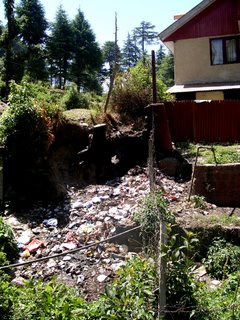
On a recent trip to Haridwar, someone had recommended visiting the Valley of Flowers. Although it was early in the season, I was secretly hoping to catch a glimpse of Uttaranchal’s known floral beauty. Taking the trolley up to the Mansa Devi temple, I looked down at the breathtaking view of Haridwar from the hill. Nearby, I was surprised to find the hillside carpeted with brightly-hued greens, blues and yellows. Seeing such splendor, a sudden joy rose up within me – until a closer inspection revealed that those weren’t flowers – they were plastic bags! What they were doing, covering the seemingly unreachable hills and dangling from branches, puzzled me.
The same vision continued to haunt me throughout my travels through northern India. Glimpses from the train window revealed lands filled with beautiful rice fields, shrubbery, languorous cows, and of course, plastic bags. From highly concentrated cities to remote dwellings, from lakes and beaches to sewage passages – India has been hit with a ‘plastic plague’. As I wrestled a bag out of a cow’s mouth on the ghat of the Ganga river, I was filled with an immeasurable sadness. In the name of convenient and cheap consumerism, we are destroying India’s environment, with one of the most unseemly potent weapons of all – plastic. Plastics, though convenient, account for much of our solid waste – and almost no method of disposal is environmentally friendly.
The urgency of the situation is clear. According to a recent article by Dr. R. Venkatesan of the National Institute of Ocean Technology, there exists a swirling pool of plastic the size of Africa in the Pacific Ocean. Nearly two million sea birds and one lakh marine mammals die each year due to this pestilence. Recent studies using autopsies on sea tortoises show balls of plastic in their stomachs, indicating their mistaking plastic to be jelly fish. The plastic which we consume invariably lands up into the ocean through various waterways, landing on beaches of islands with delicate ecosystems.
Plastic is a life-thwarting substance. Non-biodegradable in nature, it gets caught in animals’ intestines, prevents water from seeping into the soil, hinders the growth of seeds and releases dangerous chemicals through the leaching process into our water table. Plastics absorb non-water soluble chemicals such as DDT and PCBs, which turns them into second-generation toxics, meaning that they affect the progeny of the animal that has ingested them. They disrupt the hormonal functioning of the body by deceiving hormone receptors into accepting toxins over the natural estrogenic hormone, estradiol, leading to diseases affecting reproduction and brain activity. On burning, as is normally the method of garbage disposal in India, plastics release dioxins, which are known as “repeat offenders” – persistent pollutants which dissolve into our body fat and causes the impairment of liver functions and immune system, along with other vital life processes in our bodies.
Recycling of Plastics – Myth vs. Reality
We sometimes justify our use of plastic by saying that it will be recycled, or will, at least, make its way to a proper disposal site. The truth presents quite a different story. Globally, we produce nearly eight million metric tonnes of PETs (poly-ethylene-terepthalate) a year for making bottles, of which, only one-and-a-half million tones gets recycled. Recycled bottles and bags do not usually yield products of similar nature – they usually end up as non-biodegradable materials such as car bumpers. Methods for garbage disposal in India are mostly landfilling and burning – in which plastics yield dangerous by-products, either way. Recycling plants are far and few in between, and a lack of a nation-wide, systematic garbage disposal system ensures that much of our garbage is not properly disposed. For several millennia, India had relied on natural forces to decompose our mostly organic waste. Until a few decades ago, the bulk of our solid waste was carried to farms for composting – unfortunately, this is no longer a reality, as the presence of plastic bags in the garbage renders the waste useless. The garbage then ends up strewn around cities and sewages – the Bermuda Triangle for our municipal waste today.
What can we do?
Recent legislations banning plastic bag usage have not, unfortunately, been too effective in their execution. The recent Delhi Plastic Bag (Manufacture, Sales and Usage) and Non-Biodegradable Garbage (Control) Act 2000 has affected very little change. Until February this year, not a single notice had been served to an offender. The use of biodegradable plastic bags is being touted as a solution, yet very few vendors have little incentive to switch over, finding it to be an economically unviable option. It is time for the civil society to take action, determining that we are ready to follow an informed method of responsible consumerism.
As consumers, we can do the following:
- Bring your own bags when shopping and refuse to accept them at stores.
- Bring back the tradition of using jute or hardy plastic baskets when shopping for groceries. Place all vegetables together, not using individual bags.
- Accept paper packaging whenever possible – incidentally, these keep fruits fresh longer.
- Avoid eating or drinking at places that serve plastic ware. Also, avoid buying soft drinks and the like, which come in plastic bottles.
- Help educate your children, friends, household help and shopkeepers about the harms that plastic cause for the environment whenever you can!



0 Comments:
Post a Comment
<< Home